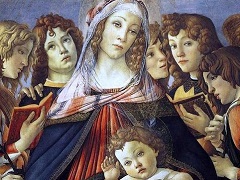The Return of Judith to Bethulia, 1472 by Sandro Botticelli

The Biblical tale of Judith, who slew Holofernes, the Assyrian king's commander-in-chief, because he represented a deadly threat for the Hebrews in Bethulia, was one of the favourite subjects of the Florentine Renaissance. Judith was considered the prototype of female strength, since she alone had summoned up the courage to murder the tyrant. In The Return of Judith to Bethulia, Botticelli shows us Judith together with Abra, her maid, the two of them striding out in a well-nigh furious manner.
Abra is carrying Holofernes' severed head on her own head, while Judith has an olive branch in her hand as a symbol of peace, which she is bringing to the Hebrews. Botticelli has succeeded here in capturing both movement and stillness in a unique balance. Judith is pausing a moment in her striding forward to turn towards the observer, self-assured if not without a touch of melancholy, exactly as if she wished to present herself as the victor. We will come to see that this interaction of striding forward and tableau, of motion and stillness, constitutes a characteristic of Botticelli's work, one that may be found in his later output as well.















